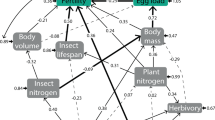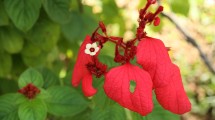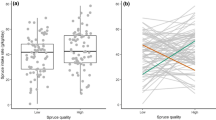Abstract
Species loss of primary producers is likely to affect processes on other trophic levels. We studied consumption and individual performance of the generalist herbivore Parapleurus alliaceus (Orthoptera) in relation to the species richness of primary producers. Adult grasshoppers were caged and left to feed for 2 weeks on experimental grassland communities ranging in plant species richness from one, two, four, eight to 32 species. Low plant diversity had a negative effect on both plant community biomass and on biomass gain of female grasshoppers, feeding to produce eggs (male grasshoppers did not gain biomass during the feeding period). This was surprising because plots with high plant diversity had a low proportion of grass biomass and grasshoppers preferentially selected grasses, leading to a greater exploitation of grasses in experimental communities of higher diversity. Thus, the concurrent increase in non-grass species in the diet from these high-diversity communities must have been beneficial to the generalist herbivore. In addition to the positive effects of plant diversity, the presence of legumes in a mixture with grasses further enhanced the biomass gain of grasshoppers at a given level of diversity. These findings suggest that plant species loss may lead to shifts in herbivore population sizes, reducing those of generalists and benefiting specialists of the remaining plant species. Our results further suggest that generalist herbivores, by having feeding preferences, can also change the relative abundances of plant species with different functional characteristics. This may feedback on both composition and diversity of plant communities.




Similar content being viewed by others
References
Aarssen LW (1997) High productivity in grassland ecosystems: effected by species diversity or productive species? Oikos 80:183–184
Bernays EA, Bright KL, Gonzalez N, Angel J (1994) Dietary mixing in a generalist herbivore: tests of two hypotheses. Ecology 75:1997–2006
Brown BJ, Ewel JJ (1987) Herbivory in complex and simple tropical successional ecosystems. Ecology 68:108–116
Chaneton EJ (1999) Herbivore-mediated plant interactions in grassland food webs. Thesis. Department of Biology. Imperial College, London
Chapman RF, Joern A (1990) Biology of grasshoppers. Wiley, New York
Curry JP (1994) Grassland Invertebrates. Chapman and Hall, London
Diemer M, Joshi J, Körner C, Schmid B, Spehn E (1997) An experimental protocol to assess the effects of plant diversity on ecosystem functioning utilized in a European research network. Bull Geobot Inst ETH 63:95–107
Givnish TJ (1994) Does diversity beget stability? Nature 371:113–114
Hector A, et al. (1999) Plant diversity and productivity experiments in European grasslands. Science 286:1123–1127
Hunter MD, Price PW (1992) Playing chutes and ladders: heterogeneity and relative roles of bottom-up and top-down forces in natural communities. Ecology 73:724–732
Huston MA (1997) Hidden treatments in ecological experiments: re-evaluating the ecosystem function of biodiversity. Oecologia 110:449–460
Ingrisch S, Köhler G (1998) Die Heuschrecken Mitteleuropas. Westarp Wissenschaften, Magdeburg
Joshi J, Matthies D, Schmid B (2000) Root hemiparasites and plant diversity in experimental grassland communities. J Ecol 88:634–644
Koricheva J, Mulder CPH, Schmid B, Joshi J, Huss-Danell K (2000) Numerical responses of different trophic groups of invertebrates to manipulations of plant diversity in grasslands. Oecologia 125:271–282
Louda SM, Keeler KH, Holt RD (1990) Herbivore influences on plant performance and competitive interactions. In: Grace JB, Tilman D (eds) Perspectives on plant competition. Academic Press, San Diego, Calif., pp 413–444
Mayer AL, Pimm SL (1997) Tropical rainforests: diversity begets diversity. Curr Biol 7:430–432
Mulder CPH, Koricheva J, Huss-Danell K, Högberg P, Joshi J (1999) Insects affect relationships between plant species richness and ecosystem processes. Ecol Lett 2:237–246
Naeem S, Thompson LJ, Lawler SP, Lawton JH, Woodfin RM (1994) Declining biodiversity can alter the performance of ecosystems. Nature 368:734–736
Payne RW, et al. (1993) GENSTAT 5 reference manual. Clarendon Press, Oxford
Pennings SC, Nadeau MT, Paul VJ (1993) Selectivity and growth of the generalist herbivore Dolabella auricularia feeding upon complementary resources. Ecology 74:879–890
Pfisterer AB, Schmid B (2002) Diversity-dependent production can decrease the stability of ecosystem functioning. Nature 416:84–86
Root R (1973) Organization of plant-arthropod association in simple and diverse habitats: the fauna of collards (Brassica oleracea). Ecol Monogr 43:95–124
Schmid B, et al. (2002a) The design and analysis of biodiversity experiments. In: Loreau M, Naeem S, Inchausti P (eds) Biodiversity and ecosystem functioning. Oxford University Press, Oxford, pp 61–75
Schmid B, Joshi J, Schläpfer F (2002b) Empirical evidence for biodiversity-ecosystem functioning relationships. In: Kinzig A, Tilman D, Pacala P (eds) Functional consequences of biodiversity: experimental progress and theoretical extensions. Princeton University Press, Princeton, N.J., pp 120–150
Siemann E (1998) Experimental tests of effects of plant productivity and diversity on grassland arthropod diversity. Ecology 79:1057–1070
Spehn EM, Joshi J, Schmid B, Alphei J, Körner C (2000a) Plant diversity effects on soil heterotrophic activity in experimental grassland ecosystems. Plant Soil 224:217–230
Spehn EM, Joshi J, Schmid B, Diemer M, Körner C (2000b) Above-ground resource use increases with plant species richness in experimental grassland ecosystems. Funct Ecol 14:326–337
Speiser B, Rowell-Rahier M (1993) Does the land snail Arianta arbustorum prefer sequentially mixed over pure diets? Funct Ecol 7:403–410
Stephan A, Meyer A, Schmid B (2000) Plant diversity affects culturable soil bacteria in experimental grassland communities. J Ecol 88:988–998
Tilman D (1997) Distinguishing between the effects of species diversity and species composition. Oikos 80:185–186
Walter T (1991) Die "Heugümper" sind in Bedrängnis geraten. Zürcher Naturschutzbund 4:1–8
Acknowledgements
We are grateful to Jasmin Joshi and Enrique Chaneton for advice with the experimental set up and to members of the BIODEPTH project for valuable suggestions. We thank Markus Fischer, Enrique Chaneton, Jasmin Joshi, Julia Koricheva for helpful comments on earlier versions of the manuscript and various assistants for help in the field. The Swiss Federal Office for Education and Science funded this project (project EU-1311 to B. Schmid).
Author information
Authors and Affiliations
Corresponding author
Rights and permissions
About this article
Cite this article
Pfisterer, A.B., Diemer, M. & Schmid, B. Dietary shift and lowered biomass gain of a generalist herbivore in species-poor experimental plant communities. Oecologia 135, 234–241 (2003). https://doi.org/10.1007/s00442-002-1169-0
Received:
Accepted:
Published:
Issue Date:
DOI: https://doi.org/10.1007/s00442-002-1169-0




